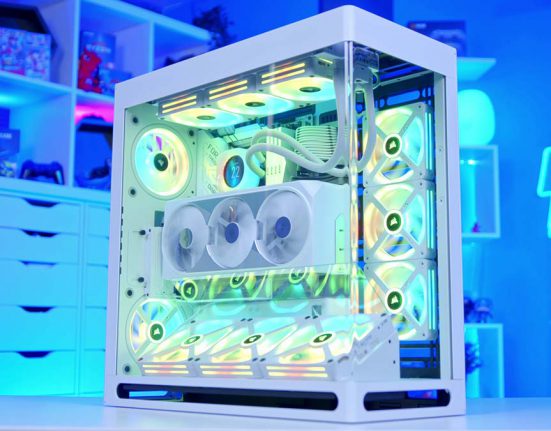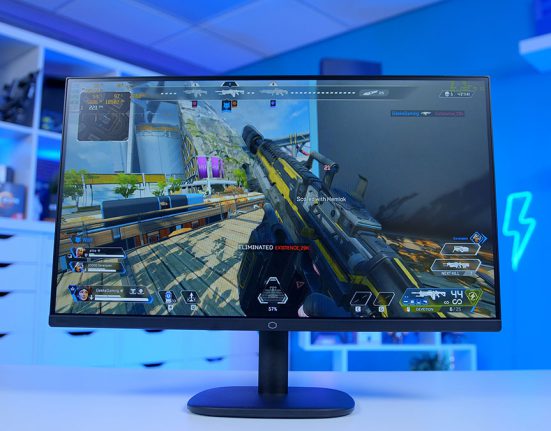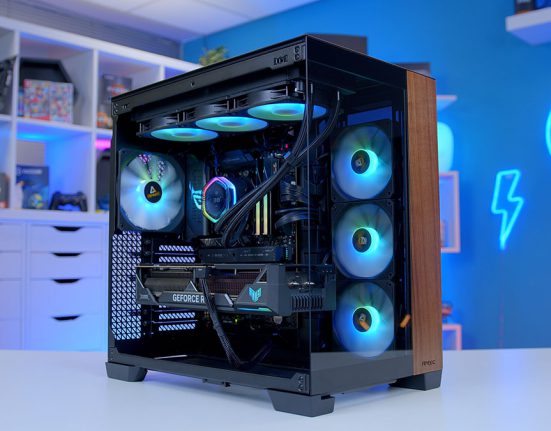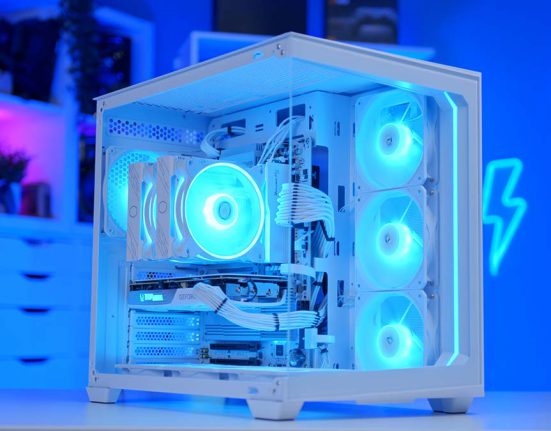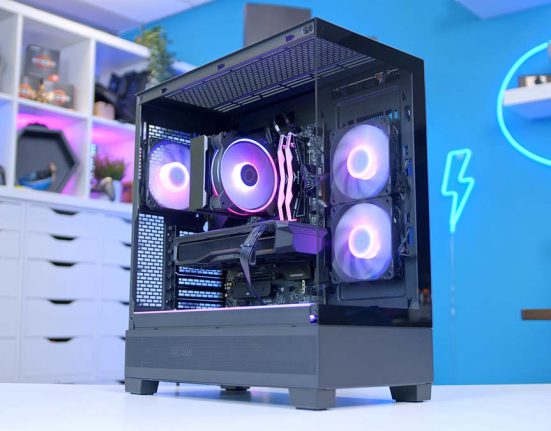Those in the market for a 1440p gaming monitor have a tremendous amount of displays to choose from. With many factors to consider, such as visual fidelity, refresh rate, size, and colour accuracy, picking the right monitor for your setup can be challenging. This is where the Tempest GP2711 comes in, offering features that cater to gamers and content creators, as Cooler Master claims. We’ve tested the Tempest GP2711 rigorously, analysing its features, design, and performance to see how it fares as a multifaceted display.
The Tempest GP2711 joins a range of other Cooler Master ‘2711’ monitors that provide different refresh rates, panel types, and response times to accommodate many buyers. The GP2711 is one of the more premium options offering excellent colour accuracy for workstation tasks and a blazing-fast refresh rate and response time, which is ideal for gaming setups. But in a market heavily filled with other excellent 1440p alternatives, we’ll be assessing whether the Tempest GP2711 has what it takes to stand out compared to the competition.


Buy the Cooler Master Tempest GP2711 on:
Specification
The Cooler Master Tempest GP2711 is a 27-inch display with a rated resolution of 2560 x 1440 (1440p). This monitor’s panel is an interesting combination of a VA LCD and quantum dots, which help improve colour accuracy and brightness. While I understand that Cooler Master has used a VA panel instead of IPS to probably make the Tempest GP2711 more affordable, IPS displays are generally more well-rounded regarding colours and viewing angles. This monitor has a reasonably fast refresh rate of 165Hz, ideal for those with strong graphics cards that can reach 165FPS on average.
The Tempest GP2711 also has two different response times based on the MPRT (Moving Picture Response Time) and GtG (Grey-to-Grey) measurements. GtG is generally more accurate than MPRT when measuring responsiveness as it analyses a hardware-level response by looking at colour shifting, while MPRT only measures how long a pixel is on the screen. Despite this, both response times (1ms through MPRT and 4ms with GtG), are fast enough that there shouldn’t be any noticeable input lag or delay during usage.
| Key Specs | Cooler Master Tempest GP2711 |
|---|---|
| Screen Size | 27″ |
| Max Resolution | 2560 x 1440 |
| Refresh Rate | 165Hz |
| Response Time | 1ms (MPRT) 4ms (GtG) |
| Colour Gamut | 99% sRGB 95% DCI-P3 |
| Peak Brightness | 1500 nits |
| Contrast Ratio | 3000:1 |
| Panel Type | VA, Quantum Dot |
| Display Inputs | 2 x HDMI 2.0 1 x Displayport 1.4 1 x USB Type-C (DP Alt) |
| Additional IO | 1 x USB 3.0 Type-B 2 x USB 3.0 Type-A 1 x Earphone Jack 1 x USB Type-C (PD 15W) |
| VRR Technology | AMD FreeSync |
The Tempest GP2711 offers a peak brightness of 1500 nits when using HDR, while typical brightness remains around 600 nits. The contrast ratio of 3000:1 is pretty solid, considering this is a VA panel. While the Tempest GP2711 won’t come close to an OLED monitor in terms of colour accuracy, this contrast rating indicates that it can provide lifelike colours in the content creation space.
Looking at IO, this monitor has three main display inputs: two HDMI 2.0 and one Displayport 1.4 port. Cooler Master has included an additional Type-C port, which features a Displayport Alt mode, ideal for those with portable setups. The Tempest GP2711 has additional ports, including an upstream USB 3.0 port, two USB 3.0 Type-A ports, and a 3.5mm earphone jack. It’s worth noting that the USB Type-C port also offers 15W of power delivery, allowing you to charge any devices.
For VRR technology, the Tempest GP2711 utilises AMD FreeSync, which minimises artifacts and ensures fresh and smooth visuals. It is a shame that the version of FreeSync being used isn’t Premium Pro, as this caters to regular HDR content consumers. Despite this, the standard FreeSync will maintain a tear-free visual experience.
Suggested Article: ASUS ProArt PA32UCXR Monitor Review
Cooler Master Tempest GP2711 Design
Like other Cooler Master monitors we’ve tested, the Tempest GP2711 has a glossy grey finish on the chassis and the stand. The casing around the display is plastic, along with the three small bezels that line the sides and top of the monitor panel. Unfortunately, the bottom bezel does jut out a bit and isn’t flush with the panel, which is a design quality we loved on the ASUS ProArt and ROG Swift ranges.
The Tempest GP2711’s plastic chassis is disappointing, considering its target market is as a premium monitor. We’ve started to see more of this with other monitors, and while it can be excused for budget displays, it would be nice to see a metal finish or a nicer-looking design on the Tempest GP2711.

Despite this, the plastic casing doesn’t impact the rigidity or structural integrity, as the Tempest GP2711 feels firm and doesn’t buckle or flex when squeezed or pinched.

While the plastic chassis is a bit lacklustre, the Tempest GP2711 stand is much more premium. The metal base is shaped like the signature Cooler Master hexagonal logo and features the same glossy grey finish as the monitor. The stand is connected to the display through the mount at the monitor’s rear, which can also be used as a VESA wall or arm mount.

The stand is very versatile, offering 15 degrees of swivel on either side; it has 110mm of height adjustment and can be tiled 20 degrees upward or 5 degrees downward. There are several ways to angle this display to suit your preferences and find the perfect viewing angle.

Furthermore, the stand has multiple rubber feet, reducing wobble or slippage on a desk. Few other manufacturers use rubber feet, so it’s nice to see that Cooler Master has included this quality-of-life feature.

The Tempest GP2711 doesn’t offer any cable cutouts to hide away clutter. However, because the IO ports are on the underside of the panel, they should be relatively easy to manage if you’re trying to keep your setup nice and clean.

The OSD joystick and power button are located towards the right side of the display. This is a strange spot for them to sit, mainly because they require you to reach quite far to access them. I didn’t realise that the power button was here until I accidentally pressed it while trying to find the joystick, so this effectively demonstrates that they might be a bit too close together.

Features We Like
Before delving into performance and colour accuracy, we’ve discussed the main features of the Tempest GP2711 monitor that we like and don’t like below.
Built-In KVM Switch
Despite not being advertised anywhere on Cooler Master’s website besides on the specs page, I was surprised to find that the Tempest GP2711 offers a KVM switch. This KVM switch is handy for those with multiple setups, as it provides a way to control two machines through just one display. The KVM mode can be found in the OSD under ‘Advanced Settings’, allowing you to switch it on or disable it.

Simple OSD
The OSD (on-screen display menu) is the monitor’s settings menu. Bringing up the OSD provides a range of settings that can be changed, such as brightness, display input, and more.
While the OSD joystick could be in a better place, the OSD itself is straightforward to navigate and offers a solid set of configuration settings. The gaming setup tab is handy as it contains all the customisation options for FreeSync, MPRT, and even additional tools that enable a timer, crosshair, or FPS counter on the screen. While more simplistic, the rest of the OSD is helpful for those who like to tinker.

The OSD’s colour adjustment section is particularly useful for creating a bespoke visual experience. To further improve colour accuracy, we recommend using a colour calibrator alongside changing these settings.

Sharp Visuals
I had reservations about this display’s visual fidelity, but the Tempest GP2711 offers exceptional image quality and responsiveness. Playing games or doing general day-to-day tasks using this monitor is very smooth. The MPRT tech is particularly impressive as it minimises motion blur during games, a vital feature for fast-paced titles.

Regarding image quality, the 1440p resolution looks very crisp, and despite the panel being VA, I didn’t feel the viewing angles were more restrictive. The layer of quantum dots significantly enhances the brightness of this display, and colours feel much more vibrant and lifelike because of this.
Incredibly Accurate Colours
The Tempest GP2711 offers excellent colour accuracy. One of the best ways to ensure your monitor accurately represents colours is by checking its ΔE (Delta E) rating. Monitors that are colour-accurate and have been calibrated well typically have a ΔE of less than two, which means your monitor shows images incredibly close to what the human eye can see. The Tempest GP2711 has an ΔE of less than two, showcasing how strong this display is as a content creation monitor.

Features We Don’t Like
Lack of Software Control
We’ve started to see more manufacturers offer dedicated software control for displays, which provides a way to configure and change settings on the fly without having to mess around with the OSD. Unfortunately, Cooler Master doesn’t offer any way to control the Tempest GP2711 with software. We hoped this display would be integrated into their MASTERCTRL or MasterPlus+ suite, but this isn’t the case.

Mostly Plastic Design
As discussed in the design section, the Tempest GP2711 features a plastic chassis with a glossy grey minimalist aesthetic. While I like the simple look, the plastic case makes this monitor look and feel cheap despite being geared towards the premium market due to its multifaceted features and higher price point than other 1440p monitors.

Colour Accuracy & Image Quality
After benchmarking and testing the Tempest GP2711 for a few days, it is clear that this display provides crisp and clean visuals, prioritising visual fidelity and responsiveness. Furthermore, the VA quantum dot panel offers vibrant whites and smooth blacks, making it an excellent option for those who regularly watch or play HDR content.
However, as a display aimed at gamers and professional content creators, this monitor needs to perform well in terms of colour accuracy. To determine if Cooler Master’s claims are correct, we ran a colour calibration benchmark with the Datacolor Spyder X Pro. This allows us to analyse the Tempest GP2711’s coverage in various colour gamuts, which we can then compare against the performance detailed on Cooler Master’s website.

According to our results from the display calibrator, the Tempest GP2711 covers 99% of the sRGB colour space, which accurately matches the advertised rating on the Cooler Master website.
Our results for the DCI-P3 rating indicated 93% coverage, compared to the 95% claimed rating on Cooler Master’s website. Ultimately, the 2% difference is so small that we can chalk this up to testing conditions, as the results are within the 10% margin of error. Overall, the Tempest GP2711 offers excellent colour accuracy, making it a solid choice for content creators.

Conclusion
Cooler Master Tempest GP2711

Product Name: Tempest GP2711
Brand: Cooler Master
-
Features
-
Design
-
Performance
-
Value For Money
Summary
The Cooler Master Tempest GP2711 is in a league of its own, offering excellent visual fidelity, fast response times, and brilliant colour accuracy. At $449, it is one of the only monitors offering a solid colour accuracy rating while also providing specs catering to gamers, such as the 165Hz refresh rate, FreeSync VRR, and anti-motion blur technology. During our testing, we found that the Tempest GP2711 provided solid coverage of the sRGB and DCI-P3 colour gamuts, and thanks to the VA quantum dot panel, colours are incredibly vibrant and lifelike.
The non-premium plastic design is the only major caveat with room for improvement. Aesthetically, the Tempest GP2711 doesn’t look great, so a metal chassis or sleeker set of bezels would make this display stand out even more than it already does. Regardless, I don’t think the lacklustre aesthetic is enough to upset most prospective buyers, as the features and excellent visual quality are extremely strong. It is worth noting that there are effectively no other colour-accurate monitors at this price point that offer characteristics geared towards gamers and content creation, making the Tempest GP2711 a highly unique display.
Pros
✅ Lifelike image quality
✅ Solid colour accuracy
✅ Competitive pricing
Cons
❌ Plastic design
❌ No software control
❌ No FreeSync Premium Pro




